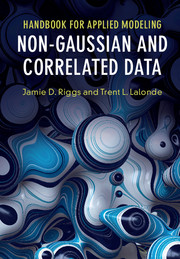Book contents
- Frontmatter
- Dedication
- Contents
- Preface
- 1 The Data Sets
- 2 The Model-Building Process
- 3 Constant Variance Response Models
- 4 Nonconstant Variance Response Models
- 5 Discrete, Categorical Response Models
- 6 Count Response Models
- 7 Time-to-Event Response Models
- 8 Longitudinal Response Models
- 9 Structural Equation Modeling
- 10 Matching Data to Models
- Bibliography
- Index
7 - Time-to-Event Response Models
Published online by Cambridge University Press: 03 August 2017
- Frontmatter
- Dedication
- Contents
- Preface
- 1 The Data Sets
- 2 The Model-Building Process
- 3 Constant Variance Response Models
- 4 Nonconstant Variance Response Models
- 5 Discrete, Categorical Response Models
- 6 Count Response Models
- 7 Time-to-Event Response Models
- 8 Longitudinal Response Models
- 9 Structural Equation Modeling
- 10 Matching Data to Models
- Bibliography
- Index
Summary
Time-to-Event Data
Time-to-event (TTE) data are used to describe the probability of an event occurring by some specified time. TTE probability differs from logistic regression as the binary response analysis is focused on determining the probability of the event any time in the study. Commonly studied TTE data include the probability of patients in a cohort to be diagnosed with a hospital-related infection following a surgery, or the probability of automobiles failing a roadworthiness test. Directly related to TTE analysis is survival analysis which is the proportion of subjects or units surviving past a specified time. Two examples of survival analysis are the proportion of patients surviving a medical procedure, and the proportion of relay switches still functioning after an electrical current surge on a power grid. These four examples are events that are dependent on time. An example of an event that is not time dependent but still a function of an ordered sequence is how many meters of mass storage magnetic tape pass over the read/write head of the tape drive before a fatal fault is detected. In each of these examples, an event of interest is a function of an ordered sequence, either time or distance.
As TTE data are dependent on an ordered sequence, it is critical to identify disturbances in the sequencing of the events. A school system wishes to administer a curriculum designed to enable passing a sequence of calculus exams to qualified students, but several of the selected students have already passed at least the first of the exams prior to administration of the curriculum. A patient in a drug protocol study enters the study, experiences the desired response to the drug, then exits the study prior to the study end. A machine part fails in the time between two scheduled, routine inspections, resulting in an indeterminate exact time of the failure. A patient enters a study but withdraws prior to either the event of interest or the termination of the study. Finally, a student has no absences in a semester used for finding the time to an absence. Each of these examples of disturbance relative to a TTE sequence is a form of censored data.
- Type
- Chapter
- Information
- Handbook for Applied Modeling: Non-Gaussian and Correlated Data , pp. 132 - 151Publisher: Cambridge University PressPrint publication year: 2017



